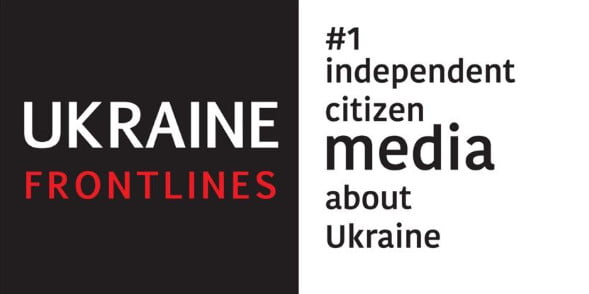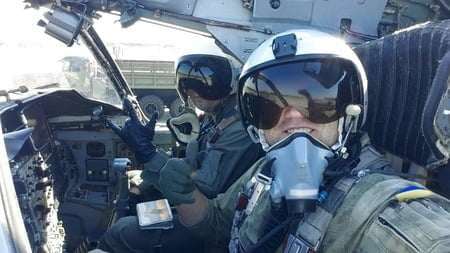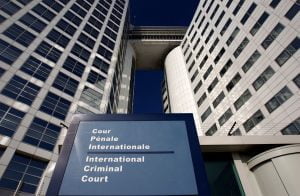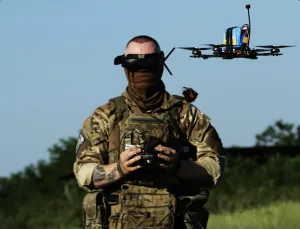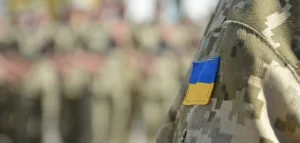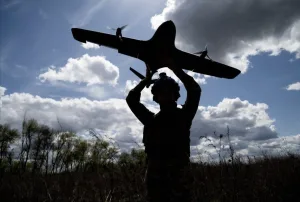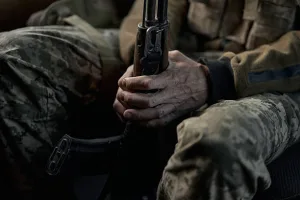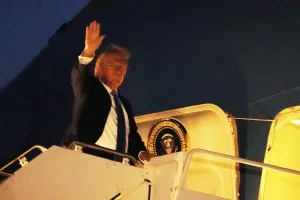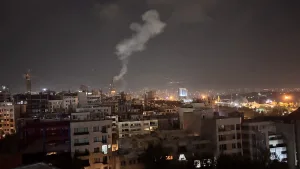Ukraine pilot tells about destroying the russian occupiers’ columns, enemy missile attacks on airfields and flying at extremely low altitudes.
His call sign is “Phantom”. This is all the personal data that can be disclosed.
– At that time, Ghost was already associated with the “Ghost of Kyiv” – the personification of all the brave pilots of our Air Force who knocked enemy aircraft out of the sky of Kyiv region, sometimes even at the cost of their own lives. “So I’m not that ‘Ghost’, but it’s a very similar call sign,” he says. “We really know how to appear from nowhere and disappear after the mission.
“Phantom” is a bomber pilot. His plane is a Su-24M frontline bomber designed to carry out missile and bomb attacks in all weather conditions and at any time of the day.
Usually, “Phantom” and its colleagues dropped four 500-kilogram bombs on the occupiers in one flight. To do this, they had to fly directly over the target at a low altitude of 100-150 meters. He did a good job against the occupiers, so he was awarded the title of Hero of Ukraine for performing combat missions. “Phantom” was also awarded the Order for Courage, III class.
He was trained in the United States and studied at the Command and General Staff College of the UK Ministry of Defense, where he received a master’s degree in military science. As a result, he is fluent in English. In February 2022, he was promoted to commander of an aviation unit.
– Commanders in military aviation are still pilots and take to the skies on an equal footing with everyone else. As the most experienced pilots, they perform the most difficult tasks. Our example is the brigade commander, Colonel Yevhen Bulatsyk. He has flown so many combat missions that it would be enough for several pilots,” Phantom says.
In a several-hour conversation with an ArmyInform correspondent, “Phantom” talks for the first time about his war with the Russian occupiers. About what the bomber feels before and during combat missions, about the targets destroyed, about the first enemy missile attacks on our airfields and their consequences, about flying at ultra-low altitudes and bombing.

There were almost fifty airplanes in the sky. Some were already running out of fuel
– At 2 am on February 24, 2022, the brigade commander calls for a call. We put everyone on alert! Work was in full swing at the airport. We received a task to withdraw aircraft from under attack. Everyone was moving fast, preparing the planes for takeoff. The airfield was like a stirring beehive. I saw that one crew was already on the plane. This is the stage of flight readiness – pilots take their seats in the cockpit and report to the flight director. So, without hesitation, the navigator and I took our helmets and quickly headed to our board as well. Meanwhile, the first plane had already released its headlights, which meant that the pilot would start the engines. It was already clear that this speed of action was definitely not a drill, but a real withdrawal of equipment from under attack. The engines started, and the planes began to take off one by one. We were assigned an airfield for withdrawal. But after takeoff, it was replaced with another one. There were almost fifty combat aircraft in the sky near the designated airfield at that time. Some of them were already running out of fuel, so the ground command team had to quickly determine who should follow whom. Managing the landing of so many planes at the same time is a difficult task. But they did a great job. After landing, we learned that the Russians had already launched air and missile strikes on Kyiv, Mariupol and other Ukrainian cities. I called my wife and asked her to go to a safe place with the children.
At that airfield, I was the senior officer of my brigade, so I ordered all the pilots to go to the bomb shelter, and I went to the command post. The control room was receiving information about new enemy attacks. The Russians were hitting many military targets. Our command posts, airfields, air defense positions, and radio engineering units were the primary targets for the occupiers. Soon we received information that missiles had hit our brigade’s airfield. The work in the sky and on the ground was on an impressive scale. Airplanes were landing and taking off like an assembly line. There were air and anti-aircraft battles. In the morning, the airfield where we landed was also attacked by the Russians. About eight cruise missiles came here. It’s hard to say whether it was a planned attack or the enemy learned about our movement and therefore struck the airfield, but the Russians failed to destroy the combat aircraft. They damaged some infrastructure facilities and the parking lot of malfunctioning aircraft, which pilots usually call the “iron row”. These are machines that had long been non-functional and were just living out their time at the airfield.
The withdrawal of aircraft from the attack in the first hours of Russian aggression proved to be an effective maneuver. We learned about the cruise missile launches from our intelligence or received information from our partners. What were the Russians doing for a long time before the large-scale invasion? Their strategic bombers were constantly taking off, going to the missile launch sites and returning. On February 24, 2022, they also went to the point of launching and fired missiles. We learned about it. This gave us the opportunity to disperse our aircraft to different airfields. Thus, we saved our aviation.
For example, there were only three airplanes in the open parking lot of our airfield that night. Of these, only two were bombers and one was a trainer. The Russians were striking at the very places where the aircraft were parked, but they were no longer there. I know that at the same time there was a massive attack on the radio and anti-aircraft missile troops. Measures were taken to change positions, to set up reserve and false positions. In this way, we managed to preserve our air defense. I remember the messages from the Russians when, in the early days, they announced the complete destruction of our aviation and air defense, and announced full control of our airspace. And what a surprise it was for them when our planes started shooting them down in air battles over Kyiv and Kharkiv regions…
The night of February 24 was probably the longest in my life. I left the brigade command post at night on February 25. I spent almost a day at the CP, but it felt like an eternity. It was one intense day, after which our lives changed completely. You can write a whole book about these 24 hours. Then we were assigned our first combat mission: to launch a bombing strike on a convoy of Russian vehicles that was moving from Chornobyl towards Bucha and Gostomel. On the morning of February 24, our pair of bombers had already worked on the convoy. On that day, we suffered our first losses: the bomber crew, a pilot and a navigator, were killed while performing a combat mission. Abruptly, we came from a relatively peaceful life to the cruel reality of a large-scale war. I can still see the pale face of my classmate, a fighter pilot, after the flight. He came back alive, but his friend was shot down in front of him. The Russians also hit command and control centers and radar and communication stations with missiles. Everyone who worked at these facilities understood that they were a target and that their lives could end at any moment. The commanders said something like this to everyone: we all understand that we can die, but this is our job, this is what we have to do for our country. And everyone went to their workplaces. We suffered losses, but the pilots still took to the skies and fought the invaders. We managed to “put down” many of their planes and destroyed a lot of equipment and occupiers on the ground.
The Russians fought not only in the sky, but also in the information space. They tried to keep us on our toes with their information and psychological operation with “marks” in fluorescent paint on the roads, reflective stickers on poles, walls and fences, and fake information about sabotage groups in all regions of the country. When people are always under stress, they act irrationally and make mistakes. I believe that this IPSO was also directed against us, the aviators. We should have been worried that our airfield was being attacked by the ubiquitous saboteurs. However, we adequately assessed the threat, strengthened security, but did not fall into paranoia. And each pilot had his own firearms. We were morally prepared to fight in the sky and defend ourselves on the ground.
We were preparing to act in conditions when the enemy was actively jamming our communications between crews, command and control centers. We expected that the loss of mobile communication would be a sign that a major invasion was about to begin. We even had an algorithm of actions – after a certain period of time, we checked for mobile communication. And if it disappeared, we would have to arrive at the designated locations at our airfields without any additional commands and act according to the situation. But this did not happen. The “second army of the world” had long intimidated us with its capabilities in electronic warfare, telling us about its “long arms,” but in reality it turned out to be a big fake. The Russians failed to break the connection, to deprive us of the ability to effectively manage our forces and resources.
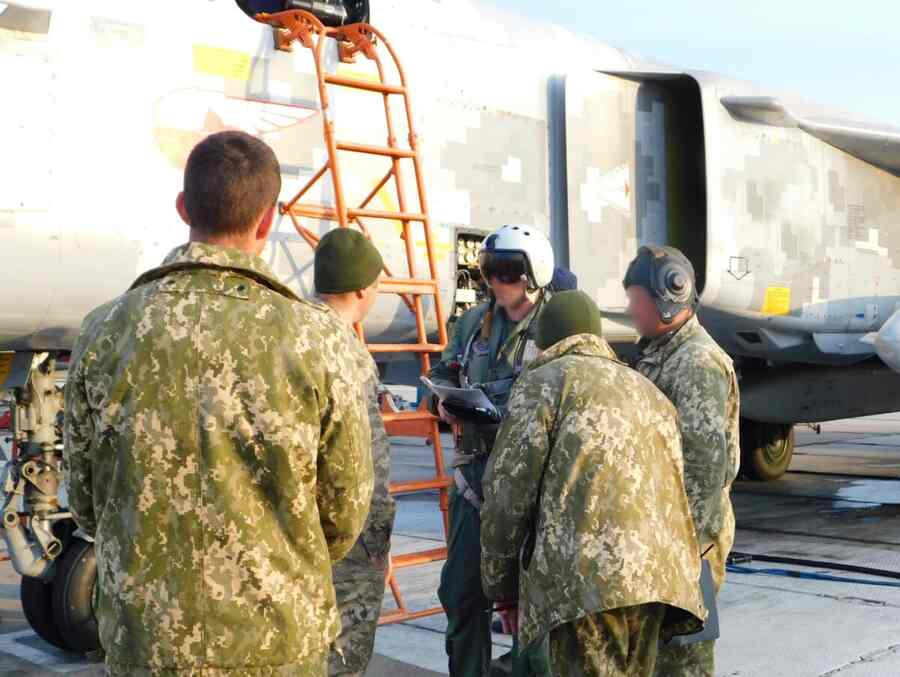
The first missile landed in the center of the runway
– There is a white circle in the center of the runway of military airfields. The first Russian cruise missile strike hit this circle. Then they hit the airplane parking lots and taxiways. They should have realized that such strikes cannot destroy the airfield. At most, they can only put it out of commission for a while. And it would be better to use concrete bombs rather than cruise missiles for such work, but in this case they would have to drop them from airplanes. For some reason, the Russians thought that after a missile strike, our aviation would no longer be able to function. To put it mildly, they were very wrong. This did not stop us. Our conclusion is that those who planned these strikes did not study well at their universities. Russian intelligence assets were not as effective as they told the world they were. The consumption of missiles was quite significant, but they did not achieve the expected results. The enemy’s plan was clear to us. They were going to stop our takeoffs by damaging the runway and destroy the fleet at the airfield parking lots. They did neither the first nor the second. In just a day, our specialists from the airfield maintenance battalion repaired all the damage to the runway. After the next arrivals, it took them only a few hours to do the same job. There is no limit to our motivation, desire to win, dedication and perseverance. Of course, missile attacks on the airfield are very unpleasant. We responded to missile warnings by hiding in shelters. You sit underground and jump from the explosions above you. Then, after the alert, you come out and look at the results. The first thing you do is check if all the people are safe. Thank God, everyone is OK. And then you look at the equipment. Sometimes it was sad. It’s when you see destroyed equipment, fires. But sometimes it came to an anecdotal result, when a cruise missile worth millions of dollars hit “object number 1” – a street toilet. Apparently, the Russians thought it was the entrance to the command center. Sometimes the missile just hit an open field. More than half of the Russian missiles did not reach their targets. We also forced them to play a game of “thimble”. This is when they have to guess where the plane will be in a few hours. And they really did not have the technical capabilities for dynamic targeting.
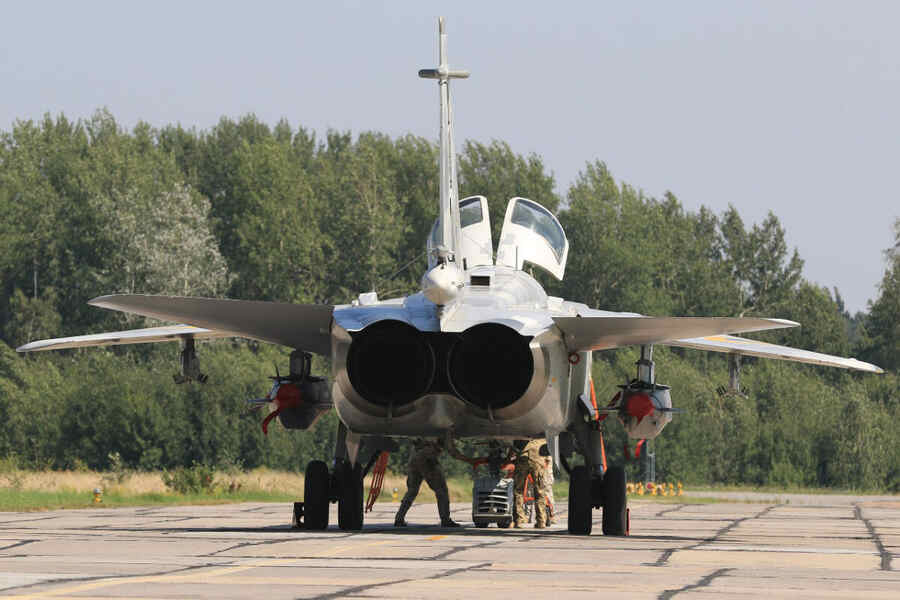
It was like a flight simulator – a long column of vehicles on a straight road
My home plane is a Su-24MR. It is a reconnaissance aircraft. Military aviators call it the “dove of peace”. Because it has not yet destroyed anyone with its camera. Another modification of this aircraft is the Su-24M bomber. Our bomber crews flew a lot of combat missions. They were simply exhausted from intensive flights and needed to rest. We, the scouts, had an idea to help our brothers. The idea of my friend and comrade-in-arms Slava Khodakivskyi, who unfortunately died, was that the scouts should start performing bomber missions. The crew of both combat aircraft consists of a pilot and a navigator. For pilots, the differences between a reconnaissance aircraft and a bomber aircraft are very minor. For navigators, there are many differences. But even before the large-scale invasion, reconnaissance crews practiced strikes on ground targets. In their turn, bombers practiced conducting aerial reconnaissance on our “doves of peace”.
That’s how scouts became bombers. We were the first volunteers to take up these flights. My first combat mission was a bombing strike on a Russian column that was breaking through to Brovary. The convoy stopped for the night in a clearing in a forest. At that time, they felt like cockroaches in a kitchen and behaved fearlessly. They all gathered in a big pile and arranged their vehicles in a straight line, car to car. And they were punished for it. For us, this was the perfect goal. To go in and put down four 500-kilogram bombs without causing any damage to civilian infrastructure. The Russians didn’t like our work, but they didn’t have time to complain. And then it went from there. We successfully joined the bomber cohort. The next flight was to relocate from one tactical airfield to another. On the way, we hit a convoy of vehicles near Okhtyrka.
At the new airfield, we joined an air group that was engaged in slowing down the advance of the Russian group from Nova Kakhovka to Kryvyi Rih. We were constantly “ironing them out” until our artillery and infantry took over this work. They were bombing the concentration of equipment near Snihurivka, Mylove, Davidovyi Brod, and Bila Krynytsia. It was like a flight simulator. There was a long straight road from Davidovyi Brod to Bila Krynytsia, and on it was a convoy of vehicles, tightly packed, car to car. A bomber’s dream. We went in and dropped bombs from the beginning of the column. I saw Msta-S howitzers and many tanks.
They took such targets that were good for us to attack. The columns that were traveling on the roads. The occupiers’ camps, which they set up for the night on the lawns of gardens or forests. At that time, we worked in groups with our brothers, the Su-25 attack aircraft, and with the helicopter pilots of the army aviation on Mi-8 and Mi-24. We attacked the convoys, returned to refuel and hang weapons, and flew out again to stop the attempt to capture Kryvyi Rih.
In about a week, the Russians realized that they were easy prey for us. The occupiers began to change their tactics. They set up their equipment for the night among the houses so that we could not strike. Then we had to wait for the beginning of their movement, when they formed a column and moved forward from the settlements. After that, they changed their tactics again. They were not moving in a tight column, but in groups with a distance of up to a hundred meters between vehicles and about a kilometer between groups of vehicles. But their mistakes in the first weeks allowed us to significantly reduce the occupiers’ potential.
So, I, a reconnaissance pilot, never thought I would become a bomber. And the next thing is that I never thought I would bomb the Russians who invaded our land. We hit them in the Kyiv region near Brovary, in the Kherson and Mykolaiv regions, and held back their offensive near Izyum and in the Donetsk region. We operated from different airfields and could “get” the occupiers in almost any corner of Ukraine and beyond. During the war, the tactics of using bombers changed. When the Russians were moving forward in columns, we used bombs. When they stopped, dug in, and pulled up air defense, it became impossible to use bombs. Guided and unguided missiles became the main arsenal of our aircraft.
I saw how I fly over the Russian Tor air defense system
– We flew at extremely low altitudes. Until 2014, Su-24M bombers never flew at an altitude of less than 200 meters. This was the limit beyond which it was forbidden to go from the point of view of flight safety. After the outbreak of the Russian-Ukrainian war in 2014 and an analysis of the existing threats, we moved the flight altitude limit to 50 meters. All these years we have been practicing and training. We planned training flights with the use of air defense equipment provided for the defense of the airfield. We were trying to sneak through their air defense unnoticed, and they were trying to detect our planes and shoot them down. It was a long and serious work. When the large-scale war started, we realized that flying at an altitude of 50 meters or lower is a good way to avoid detection by enemy air defense systems. Under 50 meters can be 49 meters or 2 meters. It all depends on the terrain. We use terrain features as our own defense. There was a time when, during a flight, I saw myself flying over a Russian Tor anti-aircraft missile system. I noticed that its antenna was active, meaning that the system was working. But I was not captured as a target, because the passage was at an extremely low altitude and at a very high speed using artificial obstacles in the terrain. It was about 900-1000 kilometers per hour. Such flights have their own peculiarities in different regions of Ukraine. In Kherson region, there is a smooth steppe. In Donetsk region, there are pipes of enterprises, waste heaps, and power lines. You have to keep your eyes open (for the pilot and the navigator) to avoid accidentally hitting a pipe from a thermal power plant or factory. Add to this terrain difficult weather conditions, such as snowfall, and it becomes clear that such flights require a lot of attention.
Of course, the Russians were hunting for our aircraft, chasing us and attacking us. Our Su-24M is unsurpassed at low altitudes and high speeds. But this does not mean that we are invulnerable. Unfortunately, we have suffered painful losses.
I can’t see their eyes before they die from my bombing strikes
– Real combat work follows the same algorithm as the training flights we were constantly conducting before the large-scale invasion. In general, it looks like this. Someone at the front, such as intelligence, finds targets for us. They send information about them to the command post. The leadership processes the data. It determines the crews that will destroy them and the weapons they will use to do so. Next, the pilots prepare. They familiarize themselves with the target and prepare their mission plan. How they will enter the target, where they will descend. A lot of conditions are taken into account, from the presence of enemy air defense systems to assessing the risk of damage to civilian infrastructure. In the process of planning, the crew can change certain aspects, suggest a different type of ammunition. After that, preparations for the flight begin. Engineers hang the weapons. The crew checks that everything is ready for the flight. There are nuances. Some targets are mobile and require a short time to prepare. Sometimes it happens that the crew needs to destroy the target no later than 30 minutes. Because the faster the strike is made, the fewer orcs will move on. I should add that with each day of the great war, the time for crew preparation decreased. This was possible, for example, when pilots had already repeatedly performed missions in a given area. I remember the record time for preparation was 15 minutes. The aircraft must also be ready for immediate operation in the sky. This is the job of our brothers, the technicians, who work 24/7 to keep the aircraft in combat readiness. Each pilot has his own traditions, something special, and it’s all very personal. Similarly, the technicians have their own traditions, which they don’t tell us about. They prepare and send the airplane to fly and wait for it to return. Waiting is the hardest part of their job. By the way, I have a special relationship with technicians because my father was also an aircraft technician.
You take the airplane up into the sky as usual. But when you approach the target, the excitement, adrenaline, heart rate, everything increases. And when you pass the target, execute an attack, move away from the target, it’s a feeling that cannot be expressed in words. I asked myself a question: how many occupiers who decided to trample our land went to a kobzon concert from my five hundred meters away? Shrapnel destroys everything up to 800 meters away. That is, an area of two kilometers is completely “ironed”. And I can’t give you an answer because I can’t see their eyes before they die from my bombing strikes. But I know there are many of them. And I have no pity for them after everything they did to our country. But it is worth emphasizing that my work is different from the work of the soldiers who see the occupiers they are shooting at. And for this I have great respect for our infantry. They are real heroes, thanks to whom our land is being liberated from the occupiers, step by step. And we, the aviators, understand this and work for them. We perform all our missions to support the main fist – the Land Forces.
Can the F-16 replace the Su-24M bomber?
The F-16 is a multifunctional fighter aircraft. But it is also a modern platform for the use of a wide range of aviation weapons in various configurations for specific missions. It can use air-to-air missiles, AIM 120 and AIM-9, HARPOON anti-ship missiles or HARM anti-radar missiles, as well as modern guided air strike weapons, including cruise missiles. By the way, the Ukrainian Air Force already has experience in using most of these weapons. The multifunctionality of this aircraft has many advantages. First, it unifies the fleet. Instead of four different types of aircraft, only one or two types of aircraft can be kept in service. This leads to the second advantage – it is easier to train pilots and maintenance personnel. It also simplifies the repair and maintenance of equipment, which reduces the burden on the country’s economy. But most importantly, having different types of weapons on board during a mission, the aircraft can destroy both air and various ground targets simultaneously. And given that the F-16 never flies alone, this increases the range of deadly weapons available to the enemy in a single mission. A rather important feature of a modern multi-role fighter is the complex of onboard equipment, which has undergone more than one stage of modernization on the F-16, and as of today it is a complex of sensors and computers that turn the process of destroying specific targets into an art. The modern concept of using air-to-ground weapons is to deliver high-precision strikes on ground targets to achieve the desired effect using smaller and fewer munitions. First of all, this reduces the likelihood of damage to civilian objects. And secondly, it reduces the cost of an air strike. The F-16 meets all the standards. And most importantly, it is equipped with modern detection and electronic warfare equipment, the database of which can be updated in accordance with the current threats of the enemy. This is truly an airplane that can change the rules of the game in this war. As I mentioned earlier, we already use some NATO munitions on Soviet aircraft. But with the F-16, we will be able to do this much more efficiently, and the issue of maintaining outdated Soviet equipment will simply disappear over time. The perseverance, motivation and experience of our pilots and technicians will allow us to put a modern multi-role fighter into service and, most importantly, into combat as soon as possible. As for the fighter pilots, attack aircraft and bombers, I can say that with their experience they can easily master these aircraft. Moreover, work in this direction is already underway.
Vladyslav Nazarkevych’s interview for ArmiaInform.
Tags: russia ukraine war russian missile attack Ukraine's missile defense Ukrainian pilot